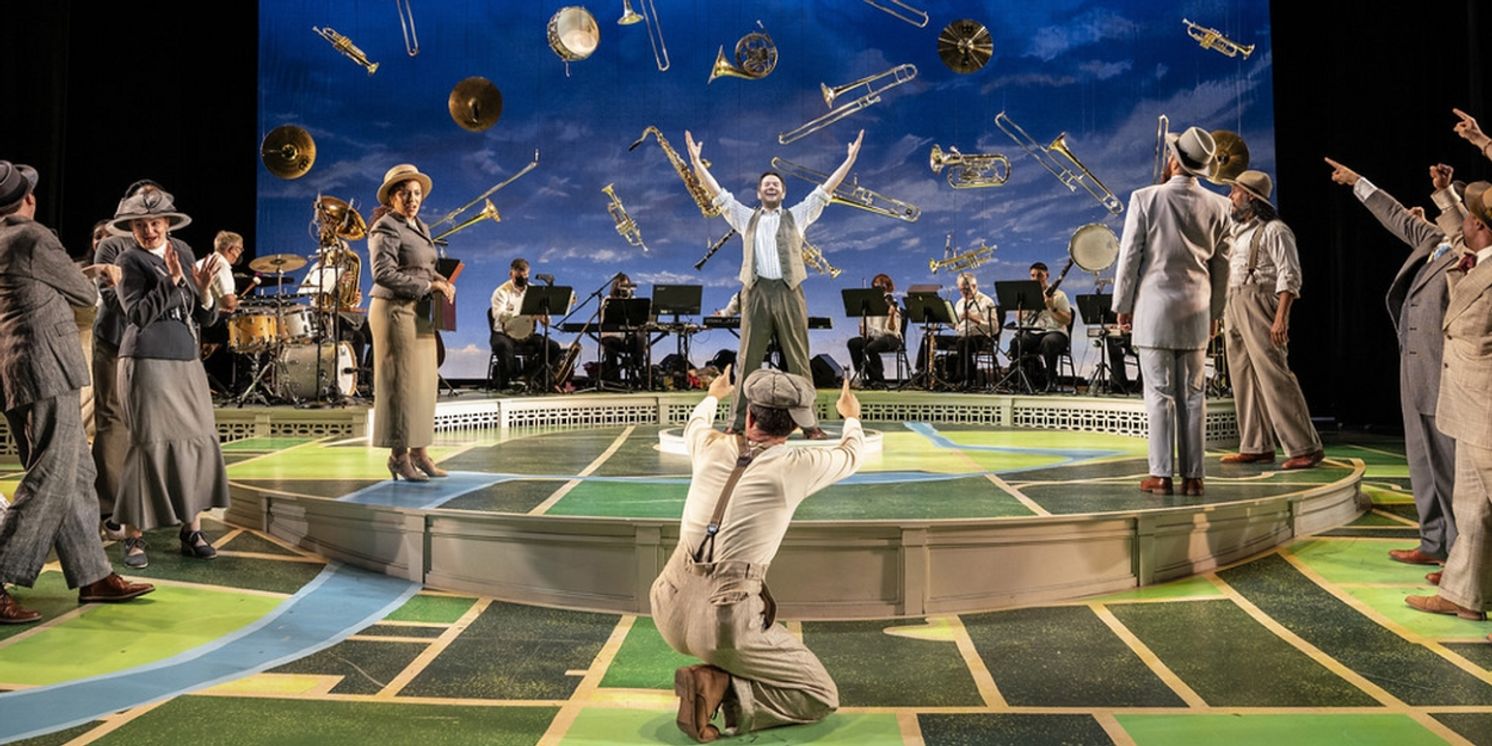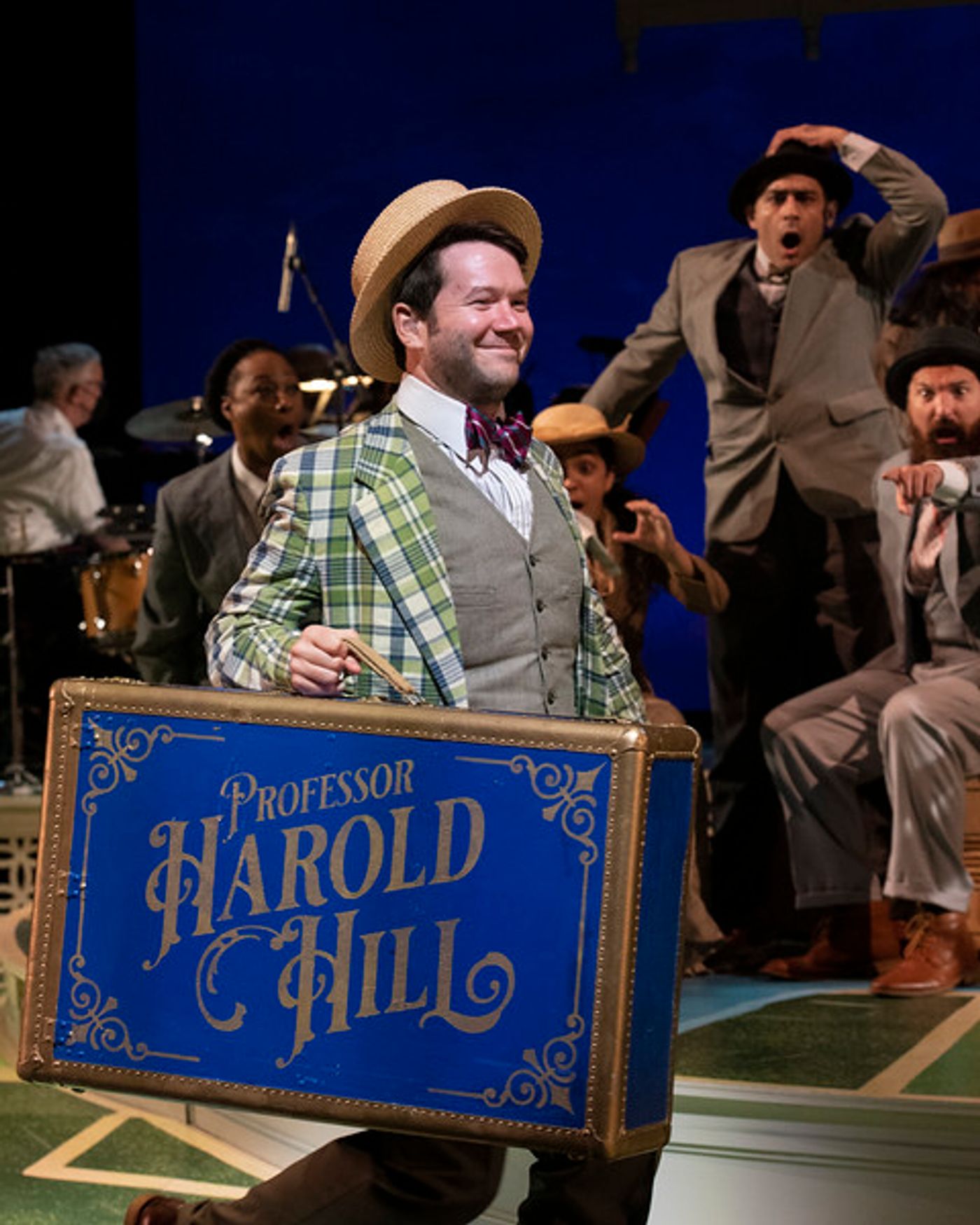
A new take on a Meredith Willson's The Music Man is playing at Olney Theatre Center, running through July 24th on the mainstage. The production is noteworthy for having a hybrid cast that is split between hearing actors and hard of hearing and deaf actors, with the performance delivered both traditionally and in American Sign Language (ASL), along with supertitles. It makes for a compelling and fresh take on this classic piece of American musical theatre.
Con man Harold Hill arrives in River City, Iowa (circa 1912) on a hot summer day, posing as a traveling salesman/professor of music, ready to save the town from the "serious trouble" it's in - namely, the addition of a pool table to the local billiards parlor. His solution? Create a boy's band, complete with instruments, instruction books, and uniforms. What follows is long cat-and-mouse game with those intent on exposing him - the town's mayor and school board, the local librarian and music teacher, and another traveling salesman who wants to see him behind bars.

Credit: Teresa Castracane Photography.
James Caverly plays Hill with the requisite panache and style the role demands. Throughout the show, he added a number of gestures and other visual touches that highlighted the energy and flair he brings to the role; his Harold is lighthearted and playful, and his character choices were fun to watch.
Playing opposite Caverly, Adelina Mitchell's Marian Paroo (the town librarian and piano teacher) is more than a match for the slick talking Hill. Mitchell has a beautiful singing voice, and wonderful comic timing, and her Marian is strong and confident - she commands the stage, and in her hands Marian is a forced to be reckoned with.
Other standout performances include Vishal Hensley as Marcellus Washburn, Hill's former sidekick turned straight arrow, and Florrie Bagel as Ethel Toffelmier (and the train Conductor). Andrew Morril adds a wonderful touch of somber gravitas as Mayor Shinn, and Amelia Hensley provides the perfect fluttering counter point as his wife Eulalie.

Scenic Designer Ethan Sinnott has created a unique set that is a significant departure from the way that the show is traditionally staged. (The Music Man is a throwback to the golden age of musicals, when scenes and songs were deliberately written to be performed in front of the curtain, while elaborate set changes took place behind it.) The set is spare and minimalist, with a large, circular platform taking up most of the center of the stage, with a corkscrewing ramp built into it that allows for a wide variety of levels and entrance points. Fixed lattice work creates a light and airy feel, and smaller moving lattice pieces are used to design smaller spaces. The minimal set allows for faster scene changes, which comes in handy, because the show runs long. Sinnott also cleverly used the fly system to lower a constellation of band instruments as The Wells Fargo Wagon brought the first act to a stirring conclusion. (The same concept was used to fly in a cloud of "shipoopi(s)" in various typefaces during the number of the same name, but the typestyles were all too modern, and created a jarring anachronism.)
Co-Directors Michael Baron and Sandra Mae Frank have created a wonderful little window into River City, and the action is natural and unforced. Karma Camp's choreography is simply breathtaking, seamlessly integrating the show's iconic dance numbers with the graceful signing of the lyrics. Music Director Christopher Youstra does his usual stellar work with both vocals and leading the orchestra, and it's a special treat to see him on stage, singing with the cast as one of the performers who voices the musical numbers for the deaf actors. (He is one of two singers, along with Bagel, to voice Rock Island, and he also sings as part of the barbershop quartet.) Special kudos go to Director of ASL Michelle Banks, as all of the cast signs all of the lines and lyrics in the show - and to the actors who had to learn two sets of lines!
All-in-all, this is a tight, well crafted, and very entertaining show. And it's also an important step forward toward creating more inclusive theatre, both on and offstage.
That said, a couple of the choices that were made in creating this show are a bit hard to understand, and they resulted in a partial production that leaves something to be desired.
In his program notes, Olney Artistic Director Jason Loewith shares how the concept of doing The Music Man with a blended cast was first workshopped back in 2019, using five Deaf and five hearing actors. After staging two numbers (Rock Island and Till There Was You), they decided that it was possible to do a musical with such a cast, and the production was set in motion.
In a traditional theatrical production (i.e.: one with hearing actors), the dialogue is simultaneously interpreted by one or more ASL interpreters. (Although typically this service is only offered for a limited number of performances.) Supertitles are also often used, either alone or in conjunction with the ASL interpreters. In this production, all of the actors deliver lines in ASL, so there is no need for interpreters. And when a deaf character has a song, someone else from the company sings the song, while the deaf actor signs and acts the number. For most of the numbers, it works well, with a couple of notable exceptions: There are only two singers "voicing" Rock Island, and it loses some of the bounce the song has when it jumps from passenger to passenger. And The Sadder But Wiser Girl is voiced by Bagel, which inserts a female presence into a number that is traditionally a "nod and wink" between Harold and Marcellus.
More critically, the production team made a decision not to have the dialogue of the deaf actors similarly voiced; in fact, when only two or three characters are interacting, they frequently use only ASL. This forces audience members who are non-ASL speakers to default to the supertitles, and they miss much of the action looking up at the proscenium. (The reasons for not having the dialogue spoken is not made clear, either from the curtain speech (which served as a demonstration of how the show would be presented) or from the extensive program notes about the creation of this production.) The viewer experience would have been greatly improved if the music and dialogue had been voiced - it could have been handled by the swings for the show, or using a pair (or quartet) of male and female actors to provide the various voices. They could have either been located somewhere on stage (perhaps as part of the orchestra), or - since the audience wouldn't need to see them - in a booth offstage. The dialogue written by Willson and Frank Lacey is hilarious - but it doesn't "read" funny. (Think of the difference between watching Abbott & Costello's Who's On First and just reading it.) One needs to hear Mayor Shinn's malaprops, the school board bickering, Zaneeta's "Ye Gods!" (and all of the other early 20th-century Iowa slang in the script) and the rest of the show's dialogue, to get the full impact of the show. A few audience members chuckled while reading the supertitles, at moments in the show that would normally draw explosive laughter. Actors feed off that energy, and the audience shares the moment. It just doesn't make sense to deprive those audience members who can hear of the full experience - more inclusive theatre shouldn't be a zero sum game where something has to be excluded, particularly when the musical numbers provide ample proof of the way the two elements compliment each other.
The other issue of note with this production is cast size (and composition). I've seen community theatre productions of The Music Man that had upwards of 90 people in them, but this production has a cast that is so spare it borders on an ensemble show, with almost everyone but Harold and Marian playing multiple roles. There are no children in the show at all - so the roles Winthrop Paroo and Amarylis are played by adult actors, and it really doesn't work. (I'd be curious to know if the cast was pared down to keep costs down, or to minimize the risk of Covid outbreaks, or for some other reason.)
Save for these two issues, The Music Man is a wonderful show that is true to the original production. And it continues Olney's commitment to diversity and inclusion, while also providing valuable insight into how hearing and deaf artists can be melded together in future productions.
Running time is approximately 2:55, with one intermission.
The Music Man runs through July 24th. For more information about Olney Theatre Center, click here.
Reader Reviews
Videos

